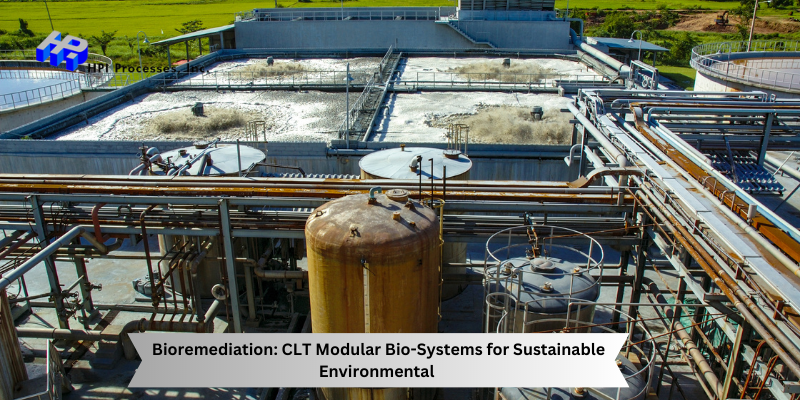Introduction
Bioremediation is a vital approach for sustainable environmental management, offering an effective and natural solution to contamination challenges. In this blog, we delve into the ground-breaking potential of CLT Modular Bio-Systems in transforming bioremediation processes.
By harnessing the power of nature and incorporating versatile technologies, CLT Modular Bio-Systems are paving the way for sustainable environmental solutions.

What is Bioremediation?
Bioremediation is a process that uses biological organisms, such as bacteria, fungi, and plants, to break down or remove contaminants from the environment. These organisms have the natural ability to metabolize or transform pollutants into less harmful substances.
What are the Applications of Bioremediation?
Bioremediation can be applied to various types of pollution, including organic and inorganic compounds, petroleum hydrocarbons, heavy metals, and pesticides. It is used in various industries and settings, such as:
- Soil Remediation: Bioremediation can be used to clean up contaminated soils, such as those affected by oil spills, industrial activities, or agricultural chemicals.
- Water Remediation: Bioremediation techniques can help treat contaminated water bodies, including lakes, rivers, and groundwater, by promoting the degradation or removal of pollutants.
- Underground Storage Tank Clean-up: Bioremediation is utilized to address leaks or spills from underground storage tanks that may contaminate soil and groundwater.
- Industrial and Petrochemical Sites: Bioremediation methods can be applied to remediate pollution caused by industrial activities, such as manufacturing, chemical production, and oil refineries.
- Mining and Landfills: Bioremediation techniques can be used to mitigate the environmental impact of mining operations and to address contamination at landfill sites.
- Wastewater Treatment: Bioremediation processes are incorporated into wastewater treatment systems to remove organic pollutants and improve water quality before discharge.
What are the Methods of Bioremediation?
There are several methods of bioremediation that can be employed depending on the specific contaminants and environmental conditions. Some of the commonly used methods include:
- Aerobic Bioremediation: This method utilizes oxygen-dependent microorganisms to break down organic contaminants into carbon dioxide, water, and harmless by-products. It is effective for treating petroleum hydrocarbons, solvents, and other organic pollutants in well-aerated environments.
- Anaerobic Bioremediation: In this method, microorganisms that thrive in oxygen-depleted environments are used to degrade contaminants. These organisms can break down substances such as chlorinated solvents, pesticides, and certain petroleum compounds in the absence of oxygen.
- Phytoremediation: Phytoremediation involves the use of plants to remove, degrade, or immobilize contaminants in soil, water, or air. Plants can absorb or break down pollutants through various mechanisms such as phytoextraction, rhizofiltration, phytodegradation, and Phyto stabilization.
- Bio stimulation: Bio stimulation involves providing nutrients, such as nitrogen and phosphorus, to enhance the growth and activity of indigenous microorganisms capable of degrading contaminants. This method is often used to stimulate the biodegradation of hydrocarbons and other organic compounds.
- Bio augmentation: Bio augmentation involves the introduction of selected microbial strains or consortia into the contaminated site to enhance the degradation capabilities. This method is used when the existing microbial population is insufficient to effectively remediate the contaminants.
- Land farming: Land farming is a technique where contaminated soil is spread over a prepared area and periodically tilled and aerated to promote microbial activity and degradation of pollutants. It is commonly used for the treatment of petroleum hydrocarbon-contaminated soils.
- Composting: Composting involves the controlled decomposition of organic waste material, such as agricultural residues or bio solids, in the presence of microorganisms. This method is used to treat organic contaminants and produce stabilized compost.
- Bioventing: Bioventing is a process that enhances the natural biodegradation of contaminants in soil by providing oxygen through the injection of air or oxygen-rich gases. It is commonly used to treat petroleum hydrocarbons and volatile organic compounds.
Benefits of Bioremediation:
- Environmentally Sustainable
- Cost-Effective
- Targeted and Specific
- Versatile
- Non-Invasive
- Reduced Secondary Waste
- Enhanced Soil and Water Quality
- Natural Restoration
- Community Acceptance
- Regulatory Compliance
What are Environmental Benefits of CLT Modular Bio-Systems in bioremediation?
- Restoring contaminated environments with the application of CLT Modular Bio-Systems.
- Examining the versatility of these systems in treating diverse contaminants.
- Minimizing the environmental impact of bioremediation processes through CLT Modular Bio-Systems.
- Preserving and protecting water resources by reducing pollution and promoting sustainable water treatment practices.
What are Economic Advantages of CLT Modular Bio-Systems in bioremediation?
- Cost-effectiveness of CLT Modular Bio-Systems for environmental remediation.
- Analysing potential cost savings and long-term economic benefits.
- Identifying additional economic advantages associated with CLT Modular Bio-Systems, such as reducing waste disposal costs and potential revenue generation through recycled resources.
Conclusion:
In conclusion, the use of CLT Modular Bio-Systems in bioremediation offers a promising and sustainable solution to address the environmental challenges caused by pollution. These systems provide a versatile and cost-effective method for restoring contaminated environments and protecting water resources, while also offering potential economic benefits. By harnessing the power of nature and incorporating advanced technologies, CLT Modular Bio-Systems have the potential to transform the field of bioremediation and pave the way for a greener and more sustainable future.
